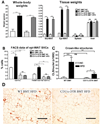Ablation of CD11c-positive cells normalizes insulin sensitivity in obese insulin resistant animals
- PMID: 18840360
- PMCID: PMC2630775
- DOI: 10.1016/j.cmet.2008.08.015
Ablation of CD11c-positive cells normalizes insulin sensitivity in obese insulin resistant animals
Abstract
Obese adipose tissue is characterized by infiltration of macrophages. We and others recently showed that a specific subset of macrophages is recruited to obese adipose and muscle tissue. This subset expresses CD11c and produces high levels of proinflammatory cytokines that are linked to the development of obesity-associated insulin resistance. Here, we used a conditional cell ablation system, based on transgenic expression of the diphtheria toxin receptor under the control of the CD11c promoter, to study the effects of depletion of CD11c+ cells in obese mouse models. Our results show that CD11c+ cell depletion results in rapid normalization of insulin sensitivity. Furthermore, CD11c+ cell ablation leads to a marked decrease in inflammatory markers, both locally and systemically, as reflected by gene expression and protein levels. Together, these results indicate that these CD11c+ cells are a potential therapeutic target for treatment of obesity-related insulin resistance and type II diabetes.
Figures






References
-
- Arkan MC, Hevener AL, Greten FR, Maeda S, Li ZW, Long JM, Wynshaw-Boris A, Poli G, Olefsky J, Karin M. IKK-beta links inflammation to obesity-induced insulin resistance. Nat Med. 2005;11:191–198. - PubMed
-
- Brake DK, Smith EO, Mersmann H, Smith CW, Robker RL. ICAM-1 expression in adipose tissue: effects of diet-induced obesity in mice. Am J Physiol Cell Physiol. 2006;291:C1232–C1239. - PubMed
-
- Cancello R, Henegar C, Viguerie N, Taleb S, Poitou C, Rouault C, Coupaye M, Pelloux V, Hugol D, Bouillot JL, et al. Reduction of macrophage infiltration and chemoattractant gene expression changes in white adipose tissue of morbidly obese subjects after surgery-induced weight loss. Diabetes. 2005;54:2277–2286. - PubMed
-
- Cinti S, Mitchell G, Barbatelli G, Murano I, Ceresi E, Faloia E, Wang S, Fortier M, Greenberg AS, Obin MS. Adipocyte death defines macrophage localization and function in adipose tissue of obese mice and humans. J Lipid Res. 2005;46:2347–2355. - PubMed
-
- Ellacott KL, Murphy JG, Marks DL, Cone RD. Obesity-induced inflammation in white adipose tissue is attenuated by loss of melanocortin-3 receptor signaling. Endocrinology. 2007;148:6186–6194. - PubMed
Publication types
MeSH terms
Substances
Grants and funding
LinkOut - more resources
Full Text Sources
Other Literature Sources
Medical
Molecular Biology Databases
Research Materials

